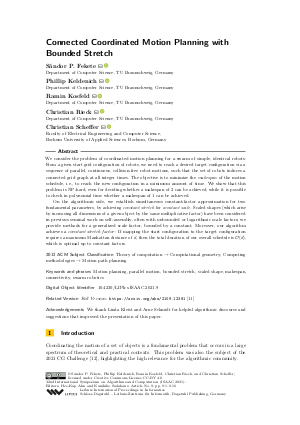@InProceedings{fekete_et_al:LIPIcs.ISAAC.2021.9,
author = {Fekete, S\'{a}ndor P. and Keldenich, Phillip and Kosfeld, Ramin and Rieck, Christian and Scheffer, Christian},
title = {{Connected Coordinated Motion Planning with Bounded Stretch}},
booktitle = {32nd International Symposium on Algorithms and Computation (ISAAC 2021)},
pages = {9:1--9:16},
series = {Leibniz International Proceedings in Informatics (LIPIcs)},
ISBN = {978-3-95977-214-3},
ISSN = {1868-8969},
year = {2021},
volume = {212},
editor = {Ahn, Hee-Kap and Sadakane, Kunihiko},
publisher = {Schloss Dagstuhl -- Leibniz-Zentrum f{\"u}r Informatik},
address = {Dagstuhl, Germany},
URL = {https://drops.dagstuhl.de/entities/document/10.4230/LIPIcs.ISAAC.2021.9},
URN = {urn:nbn:de:0030-drops-154423},
doi = {10.4230/LIPIcs.ISAAC.2021.9},
annote = {Keywords: Motion planning, parallel motion, bounded stretch, scaled shape, makespan, connectivity, swarm robotics}
}

 Creative Commons Attribution 4.0 International license
Creative Commons Attribution 4.0 International license
